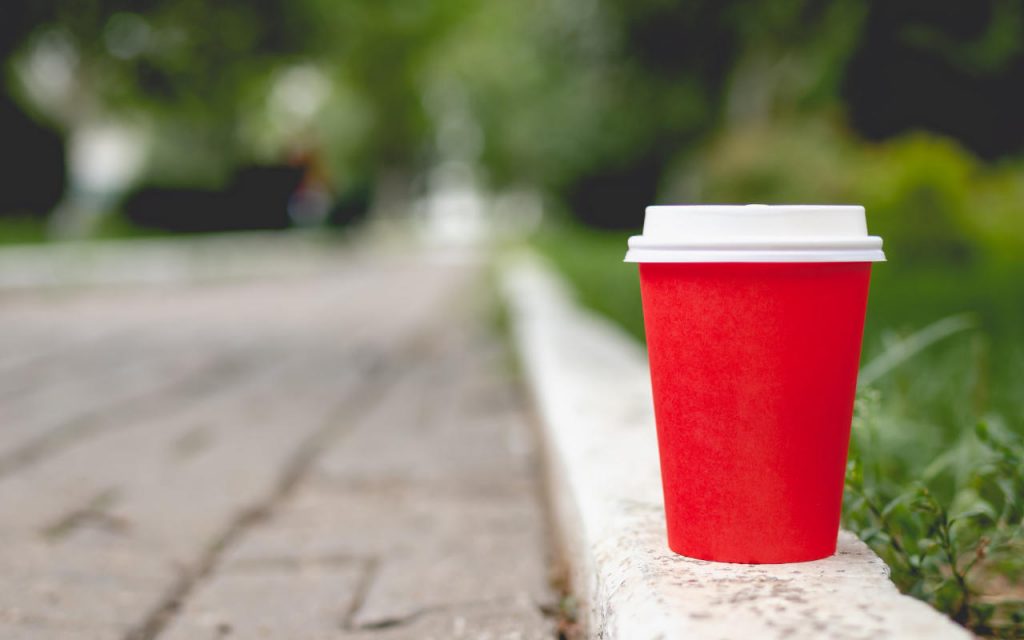From water bottles to bin bags, from plastic forks to cocktail stirrers – the world is full of single-use plastics. Plastic packaging, used to store and transport goods, is largely unseen, but packaging waste is a huge part of the problem: 40 percent of plastic produced is packaging.
That’s why taking steps to recycle and reuse plastic, wherever possible, is so important – and at NPF Packaging, we’re committed to our fully recyclable plastic packaging (and our packaging made from recycled materials).
But do we still really need to use single-use plastic packaging, and what types are the most common?

Single-use plastic packaging
The most commonly seen single-use plastic packaging items are drinks containers and food packaging:
- Takeaway coffee cup lids
- Water bottles
- Takeaway boxes
- Food packets
- Drinking straws and stirrers
- Plastic cutlery
- Shopping bags
That’s because these are publicly available, frequently littered consumables. Somewhat under the radar, single-use plastics are also consumed in industry, logistics and consumer goods packaging; pallet wrap, polythene sheeting, poly bags and polythene liners, for instance.
Thankfully, these kinds of industrial packaging materials are easily recycled – and many can be made from recycled plastic, too. Plenty of businesses have stepped up to improve their plastic recycling efforts, with retailers and logistics companies working hard to make improvements.
For all the efficiency and reduction of waste, though, plastic packaging is still essential. And while alternatives are available, they’re not always what they seem – with their own drawbacks as well as advantages.
Plastic packaging alternatives
There are quite a few alternatives to plastic packaging these days – each with their own unique properties.
Paper and cardboard
Advantages
- Easily recycled, sustainable production
- Totally biodegradable
- Has a highly marketable look and feel for certain brands
- Good protection from impact
Disadvantages
- Heavier and more expensive
- May not suit all branding
- No moisture protection
- Only recyclable a handful of times before degrading
- Water-intensive production
Cardboard packaging can be very versatile and attractive, with good protection from impacts. But it can’t be used for everything. And, while production is sustainable (and offers carbon offsetting advantages), it’s also highly water-intensive.
Bioplastic
Advantages
- Works exactly like normal plastic
- Can be broken down in a composter, into natural compounds
- Gives an eco-friendly image
Disadvantages
- Higher cost than plastic
- Requires industrial composting, or will have the same impact of normal plastic
- Further environmental impact from production
The promises made by biodegradable plastic are big – which makes it all the more heartbreaking that they’re so easily broken. Despite the claims that bioplastic breaks down into natural elements, it requires huge amounts of energy and an industrial composting process in order to do so. It’s production is also problematic, requiring land clearing and large volumes of fresh water.
Read more – Eco-friendly plastics: biodegradable Vs recycled plastic
Glass
Advantages
- Infinitely recyclable
- Totally inert – breaks down into natural silicates (sand)
- Attractive finish
Disadvantages
- Extremely heavy compared to plastic
- Brittle and fragile
- Narrow range of uses
- Production can be dirty – quarrying and melting
Glass is a beautiful, tarnish-free material – but it’s not versatile or strong enough to use for packaging beyond bottles. While the product itself could be classed as eco-friendly, its production can be dirty and damaging to the environment, and broken glass is a danger to public health.
Why do we still need single-use plastic packaging?
Single-use plastic packaging is really useful stuff. It reduces food waste, production costs and prevents contamination. It protects all kinds of products in shipping and in storage. It’s still the go-to solution because nothing can match the versatility, price and effectiveness of plastic packaging.
It might sound a little bit against common sense, but it also has environmental benefits. Plastic packaging is extremely strong, lightweight and compact, which reduces transport emissions – and recycling and reuse are more viable than for easily contaminated materials, like paper and card.
There’s no denying that plastic packaging is an essential requirement in today’s world – and as long as reuse and recycling are optimised, it can still work with the planet rather than against it.
The advantages of polythene bags
- Lightweight
- Durable
- Prevent contamination
- Versatile
- Cost-effective
- Recyclable
- Can be made from recycled material
- Can be repurposed
What are the disadvantages of polythene bags?
The key disadvantage of single-use polythene bags is disposal. It’s up to the end user to ensure proper sorting and recycling – and as we know, that doesn’t always happen.
Plus, polythene bags are only recyclable a certain number of times before the quality degrades. But at this stage, they can be transformed into more permanent fixtures; like playground equipment, or benches and street furniture.
Still, when reused and recycled, properly managed polythene remains one of the most versatile and eco-friendly packaging materials in the world.
Fully recyclable packaging solutions – from NPF Packaging
The friendly team at NPF Packaging can help you find an eco-friendly packaging solution for your business. Choose from our fully recyclable polythene packaging, and our bespoke cardboard range as a plastic packaging alternative.
Get a quote now, or call us on 01773 820415.


